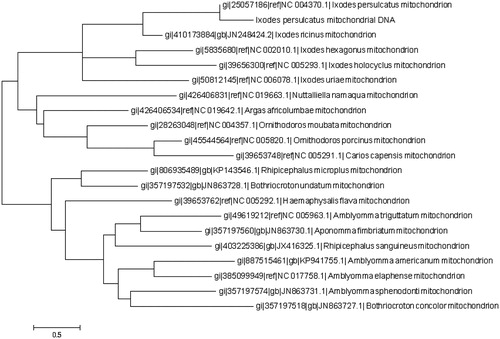Abstract
Ixodes persulcatus is a species of hard tick which is a predominant tick species that spreads a wide array of serious human and animal pathogens. Here, we first assemble the complete mitogenome of I. persulcatus of China. The total length of the mitogenome was 14,539 bp included 36 genes and with a mitogenome structure similar to other ticks. Phylogenetic tree was constructed based on the complete mitogenome of I. persulcatus and closely related 19 species ticks to assess their phylogenic relationship and evolution. We also analyze the differences between the mitogenomes of I. persulcatus of Japan and China. The complete mitogenome data would be useful for further study of I. persulcatus.
Keywords:
Ixodes persulcatus is a species of hard tick distributed from Europe through central and northern Asia to China and Japan, which is a predominant tick species that spreads a wide array of serious human and animal pathogens, including Borrelia garinii, which causes Lyme disease (Ai Citation1990; Cao et al. Citation2000), Borrelia miyamotoi, one of the relapsing fever borreliae, Anaplasma phagocytophilum, the causative agent of human granulocytic anaplasmosis (Cao et al. Citation2003). In addition to this information, I. persulcatus has recently drawn some attention as a vector for tick-borne encephalitis virus (Jääskeläinen et al. Citation2011), Babesia (Sun et al. Citation2008; Niu et al. Citation2016), and spotted fever group rickettsiae (Jia et al. Citation2013; Sun et al. Citation2015).
In this study, we first reported the complete mitogenome of I. persulcatus of China. A proportion of eggs, larvae, males, and females adults of ticks were collected in the forest region of Sui Fenhe, Hei Longjiang province, China. After morphological identification, the specimens were kept in the laboratory at −80 °C under the accession number SFH2714. The specimens were homogenized individually using metal beads and resuspended in phosphate-buffered saline (PBS); total genomic DNA was extracted using a Tiangen DNA extract kit (Tiangen Inc., Beijing, China) following the manufacturer’s instructions. DNA was stored at −20 °C. The total length of its mitogenome was 14,539 bp, with a genome size similar to other ticks (Xu et al. Citation2014). The accurate annotated mitochondrial genome sequence was submitted to GenBank with accession number KU935457. The complete mitogenome has 13 protein-coding genes, 21 transfer RNA genes, and 2 ribosomal RNA genes. The 12S and 16S rRNA genes were 718 bp and 1206 bp in length, respectively. The ribosomal subunit genes were located between the tRNA-Leu and tRNA-Ile genes and further separated by the tRNA-Val gene. The total base composition of the mitogenome is A (37.8%), T (39.55%), C (14.38%), and G (8.27%). Which shows AT bias, with the AT content of 77.35%. The percentage of GC (22.65%) was lower than AT rate, which was generally in accordance with other invertebrate mitochondrial genomes.
To further validate the new sequences, we used all of mitochondrial genome sequences published in Genbank of other tick species to construct the phylogenetic tree. These species were as follows: Ixodes persulcatus, Ixodes ricinus, Ixodes hexagonus, Ixodes holocyclus, Ixodes uriae, Rhipicephalus microplus, Rhipicephalus sanguineus, Bothriocroton undatum, Bothriocroton concolor, Haemaphysalis flava, Amblyomma triguttatum, Aponomma fimbriatum, Amblyomma americanum, Amblyomma elaphense, Amblyomma sphenodonti, Argas africolumbae, Carios capensis, Ornithodoros moubata, Ornithodoros porcinus, and Nuttalliella namaqua. We used MEGA6 to produce the phylogenetic tree based on the maximum-likelihood method (). The phylogenetic analysis results support that the mitochondrial DNAs of Ixodes persulcatus are more closely related to other species of Ixodes genus. Compared with the only other I. persulcatus mitogenome of Japan (Shao et al. Citation2005), there were 7 bases insertion, 7 bases deletion, and 31 bases substitution in the new I. persulcatus mitogenome of China we sequenced.
Disclosure statement
The authors report no conflicts of interest. The authors alone are responsible for the content and writing of this article.
Reference
- Ai CX, Hu RJ, Hyland KE, Wen YX, Zhang YG, Qiu QC, Li DY, Liu XD, Shi ZX, Zhao JH, et al. 1990. Epidemiological and aetiological evidence for transmission of Lyme disease by adult Ixodes persulcatus in an endemic area in China. Int J Epidemiol. 19:1061–1065.
- Cao WC, Zhao QM, Zhang PH, Dumler JS, Zhang XT, Fang LQ, Yang H. 2000. Granulocytic Ehrlichiae in Ixodes persulcatus ticks from an area in China where Lyme disease is endemic. J Clin Microbiol. 38:4208–4210.
- Cao WC, Zhao QM, Zhang PH, Yang H, Wu XM, Wen BH, Zhang XT, Habbema JD. 2003. Prevalence of Anaplasma phagocytophila and Borrelia burgdorferi in Ixodes persulcatus ticks from northeastern China. Am J Trop Med Hyg. 68:547–550.
- Jääskeläinen AE, Tonteri E, Sironen T, Pakarinen L, Vaheri A, Vapalahti O. 2011. European subtype tick-borne encephalitis virus in Ixodes persulcatus ticks. Emerging Infect Dis. 17:323–325.
- Jia N, Zheng YC, Jiang JF, Ma L, Cao WC. 2013. Human infection with Candidatus Rickettsia tarasevichiae. N Engl J Med. 369:1178–1180.
- Niu Q, Liu Z, Yang J, Yu P, Pan Y, Zhai B, Luo J, Yin H. 2016. Genetic diversity and molecular characterization of Babesia motasi-like in small ruminants and ixodid ticks from China. Nfect Genet Evol. 11:30078.
- Shao R, Barker SC, Mitani H, Aoki Y, Fukunaga M. 2005. Evolution of duplicate control regions in the mitochondrial genomes of metazoa: a case study with australasian ixodes ticks. Mol Biol Evol. 22:620–629.
- Sun J, Lin J, Gong Z, Chang Y, Ye X, Gu S. 2015. Detection of spotted fever group Rickettsiae in ticks from Zhejiang Province, China. Exp Appl Acarol. 65:403–411.
- Sun Y, Liu G, Yang L, Xu R, Cao W. 2008. Babesia microti-like rodent parasites isolated from Ixodes persulcatus (Acari: Ixodidae) in Heilongjiang Province, China. Vet Parasitol. 156:333–339.
- Xu P, Zhao Q, Li X, Wang J, Guo L, Liu XG. 2014. Complete mitochondrial genome of cattle tick (Rhipicephalus microplus). Mitochondrial DNA. 27:529–530.

